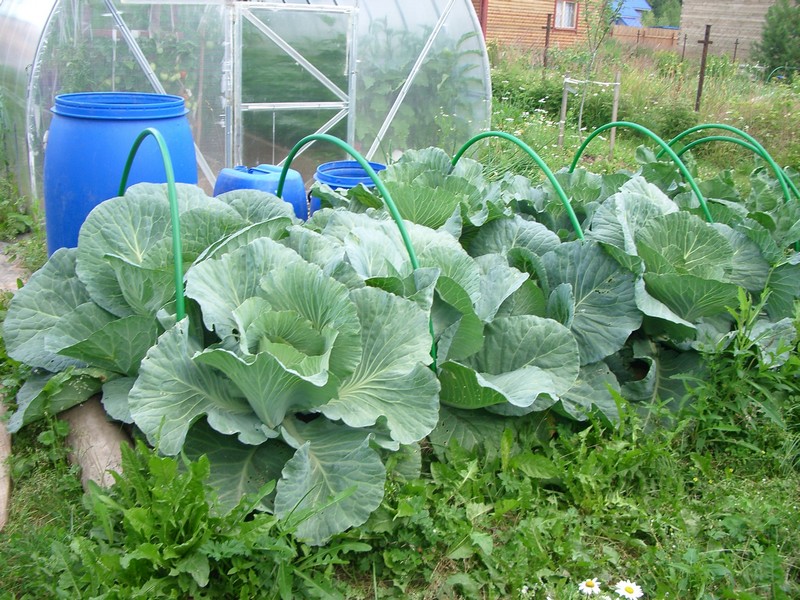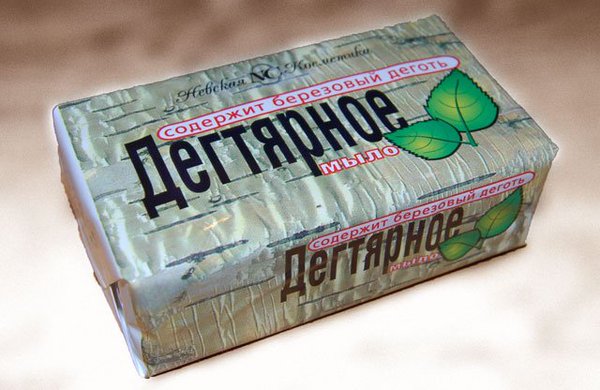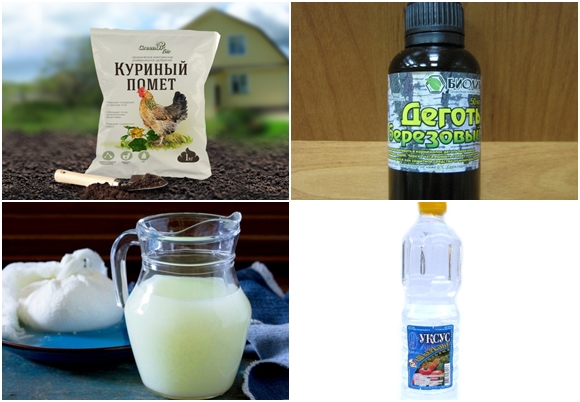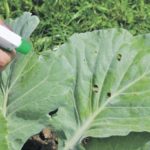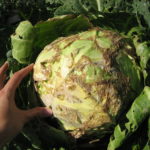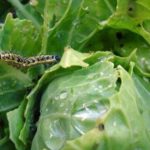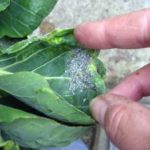Gardeners who grow vegetables for their own table understand that the fewer chemicals used in the process of growing cabbage, the fewer harmful substances will get into the food. How to treat cabbage against pests - folk remedies or commercially available compounds?
The answer from experts is clear - first you need to try all the home methods of controlling cabbage pests and only then move on to radical measures to save the crop.
What you need to know if a pest is found
How to fight cabbage pests with folk remedies? Not all insects are dangerous for vegetables, and some of them can even be called helpers in this battle. These include ladybugs and earwigs, which readily collect aphids from cabbage leaves, as well as hoverflies, which eat larger insects. Many owners resort to cunning, specifically luring these insects to their garden in order to protect the harvest in advance.
To attract earwigs, boxes with soil sprinkled with fresh wood shavings are placed along the garden, and to attract hoverflies, dill or parsley are planted right between the beds.
Treatment of cabbage against pests is carried out closer to sunset so that the composition applied to the plants does not evaporate longer. In the intervals between spraying, which should be carried out regularly, it is useful to generously wash the heads of cabbage with a weak soap solution, especially those places where aphids are found. Systematically checking the underside of cabbage leaves, where these insects like to accumulate, should become a habit.
So what should you use to spray cabbage against pests – folk remedies or chemicals?
Universal methods of getting rid of pests
Traditional methods of control can be aimed at expelling one type of insect or act in combination. Universal means of getting rid of cabbage pests using folk remedies without chemicals are those that, when exposed to them, remove most of the pests from the garden:
- Milk serum;
- Birch tar;
- Soap solution;
- Wormwood and other plants.
So - cabbage pests and how to deal with them:
- The serum is applied no more than three times per season and the effect after spraying is immediately noticeable - the vegetable rapidly begins to grow, and the insects leave after the first procedure.Spraying is carried out with undiluted, strained liquid. Whey is also used as a top dressing for cabbage;
- An armful of fresh wormwood, spread out in several branches between the rows, will protect the crop from pests, but you must remember to periodically replace dried wormwood with fresh one. A decoction is made from wormwood. About one and a half kilograms of grass are chopped directly in a bucket, then 12 liters of water are poured in and removed for 2 days. Then the mixture is boiled for 30 minutes, filtered, topped up with water in a volume twice as large as what was received, and the vegetables are sprayed with this cooled mixture;
- Celandine grass will help preserve the harvest if you apply the solution 3-4 times per season. To do this, about half a kilogram of grass, finely chopped with a knife, is poured with 1.5 liters of water and the mixture is removed for three days. The strong concentrate is used without diluting, immediately after filtering;
- Finely grate half a bar of natural laundry soap, add 5 liters of warm water and sprinkle on the plants. Often, soap is combined in solutions with other ingredients, for example, essential oils of mint or wormwood. Birch tar dissolves well in soap solution;
- An ordinary finely chopped onion (20 g), or the upper orange scale of a lily (about 6-7 g) is poured with a liter of cold water and left for 6-8 hours in a sealed container, after which the liquid can be used to combat cabbage pests;
- 0.5 cups of coarsely chopped hot pepper should be steamed with boiling water (1 liter) and simmer for an hour, covered over low heat. Then the broth is infused for at least a day, after which it is filtered and you can start spraying. When there are a lot of insects, it is advisable to increase the properties of the pepper infusion by adding 2-3 teaspoons of washing powder to it.
It should be noted that serum and soap solution, being general-purpose repellents, nevertheless have little effect on the slugs and snails present in the garden.
Aphid
If in the spring strange brownish spots began to appear on the young leaves of the seedlings, and some individual leaves began to curl, the reason for this can be found on the back of the leaves. If you see small drop-shaped greenish-whitish insects clinging to the underside of the leaf, it means that the growing cabbage has been infected by aphids. How to spray cabbage in this case?
The most effective remedy for aphids is birch tar. Both the natural resins of the product and soap containing this substance are used.
It is impossible to kill aphids with tar. As in most cases of using folk remedies for pests of cabbage, when watering with the solution, a repellent effect is achieved - insects already present on the leaves are washed off to the ground, and new ones, scared off by the strong smell, bypass the garden.
How to protect cabbage from pests using tar soap? Half the bar is grated and diluted with a liter of hot water. Then a teaspoon of tar is added to the solution and the entire mixed composition is poured into a 20-liter container of warm water. The mixture is ready for spraying.
Try to expel these pests using other folk remedies:
- Dry mustard (2 teaspoons), mixed with 2 teaspoons of grated soap, then tobacco dust (80 g) is added. The dry mass is poured with boiling water and left for 24 hours to infuse, after which it is filtered and used;
- For half a kilogram of dry onion peel, take up to two kg of fresh tomato greens and 1 teaspoon of any liquid laundry detergent. Separately, pour boiling water over the tomato grass (5 liters) and husks (2 liters) and leave for 24 hours. Before mixing in one container, liquid laundry detergent is added to the onion solution, and the tomato water is heated over low heat for 2-3 hours;
- Boil 1 medium onion, 4 heads of unpeeled garlic and a glass of wood ash and leave for 24 hours. After filtering, dilute the liquid with a bucket of water and add 1 teaspoon of washing powder.
A sufficient preventative effect against aphids is to sprinkle cabbage rows with mustard powder.
Cruciferous flea beetles
Flea beetles very quickly make a cabbage bed unusable, so control of cabbage pests in open ground should begin as soon as these jumping insects are noticed. They usually choose from two main methods of processing the vegetable: the product can be sprinkled on the plants in the form of a dry substance or the cabbage can be sprinkled with the prepared solution.
Used as a dry repellent tobacco dust from pests, ash, paprika and hot pepper powders. You need to sprinkle the cabbage immediately after watering, straining the powder through thick cheesecloth.
The following liquid infusions are used:
- Chicken manure diluted in the amount of 1 glass of the substance in 20 glasses of water (infusion time - 21 days);
- Birch tar (1 tablespoon per 10 liters of soap solution);
- Whey in its pure form;
- A solution of 1 glass of table vinegar dissolved in 10 liters of water.
If none of the above methods help, try treating the cabbage leaves with dried toothpaste taken from an old tube. In total you will need 1 tbsp.spoon of pasta. It is dissolved in 5 liters of warm water and generously sprinkled on the beds.
Slugs and snails
If the bottom cabbage leaves have holes, then slugs are most likely to blame. All known high-level protection methods can be used against these pests, since simple soapy water or whey will not help.
- We get rid of snails using ammonia. A total of 60 ml of liquid must be dissolved in a bucket of water and sprinkled with the solution twice, with a pause of 10-15 minutes;
- You can treat the soil between the plants and the cabbage itself with nettle infusion, this will also increase the vegetable’s resistance to various diseases. Take 1 part fresh, crushed plant to 10 parts water and leave the mixture to ferment for a week. Then the resulting infusion is diluted with water to obtain a 10% concentration and used;
- You can also protect cabbage with the top part of a potato bush, for which the greens are chopped and infused in water for about three hours;
- An already proven remedy, tar, will expel slugs from the area for a long time with its strong odor.
The most important aspect in preventing pest activity in the garden is several stages of initial spraying, undertaken before the insects are even noticed. By doing preventive measures, you simultaneously instill in the plants a strong immunity from unwanted invaders, and subsequently, the question of how to get rid of them will no longer be so pressing.

